Martin of Tours
| Saint Martin of Tours | |
|---|---|
|
Statue of Saint Martin cutting his cloak in two. Höchster Schloss, Höchst. | |
| Bishop and Confessor | |
| Born |
316 or 336 AD Savaria, Diocese of Pannonia (modern-day Hungary) |
| Died |
November 8, 397 Candes, Gaul (modern-day France) |
| Venerated in |
Roman Catholic Church Eastern Orthodox Church Oriental Orthodoxy Anglican Communion Lutheranism |
| Feast |
11 November (Roman Catholic Church, Lutheran Church, and Anglican Communion) 12 November (Eastern Orthodox Church) |
| Attributes | man on horseback sharing his cloak with a beggar; man cutting cloak in half; globe of fire; goose |
| Patronage | against poverty; against alcoholism; Baħrija, Malta; beggars; Beli Manastir; Archdiocese of Bratislava; Buenos Aires; Burgenland; cavalry; Church Lads' and Church Girls' Brigade; Dieburg; Edingen equestrians; Foiano della Chiana; France; geese; horses; hotel-keepers; innkeepers; Kortrijk; diocese of Mainz; Montemagno; Olpe; Ourense; Pietrasanta; Pontifical Swiss Guards; quartermasters; reformed alcoholics; riders; Taal, Batangas; Bocaue, Bulacan; Diocese of Rottenburg-Stuttgart; soldiers; tailors; Utrecht; vintners; Virje; wine growers; wine makers; Wissmannsdorf and Villadoz |
St. Martin of Tours (Latin: Sanctus Martinus Turonensis; 316 or 336 – 8 November 397) was Bishop of Tours, whose shrine in France became a famous stopping-point for pilgrims on the road to Santiago de Compostela in Spain. He has become one of the most familiar and recognizable Christian saints. As he was born in what is now Szombathely, Hungary, spent much of his childhood in Pavia, Italy, and lived most of his adult life in France, he is considered a spiritual bridge across Europe.[1]
His life was recorded by a contemporary, the hagiographer Sulpicius Severus. Some of the accounts of his travels may have been interpolated into his vita to validate early sites of his cult. He is best known for the account of his using his military sword to cut his cloak in two, to give half to a beggar clad only in rags in the depth of winter. Conscripted as a soldier into the Roman army, he found the duty incompatible with the Christian faith he had adopted and became an early conscientious objector.
Life
Soldier
Martin was born in 316 or 336 AD in Savaria in the Diocese of Pannonia (now Szombathely, Hungary). His father was a senior officer (tribune) in the Imperial Horse Guard, a unit of the Roman army, later stationed at Ticinum (now Pavia), in northern Italy, where Martin grew up.[2] The date of his birth is a matter of controversy, with both 316 and 336 having rationales.[3]
At the age of ten he attended the Christian church against the wishes of his parents, and became a catechumen. Christianity had been made a legal religion (in 313) in the Roman Empire. It had many more adherents in the Eastern Empire, whence it had sprung, and was concentrated in cities, brought along the trade routes by converted Jews and Greeks (the term 'pagan' literally means 'country-dweller'). Christianity was far from accepted amongst the higher echelons of society; among members of the army the worship of Mithras would have been stronger. Although the conversion of the Emperor Constantine and the subsequent programme of church-building gave a greater impetus to the spread of the religion, it was still a minority faith.
As the son of a veteran officer, Martin at fifteen was required to join a cavalry ala. At the age of 18 around 334 or 354, he was stationed at Ambianensium civitas or Samarobriva in Gaul (now Amiens, France).[2] It is likely that he joined the Equites catafractarii Ambianenses, a heavy cavalry unit listed in the Notitia Dignitatum. As the unit was stationed at Milan and is also recorded at Treves, it is likely to have been part of the elite cavalry bodyguard of the Emperor, which accompanied him on his travels around the Empire.
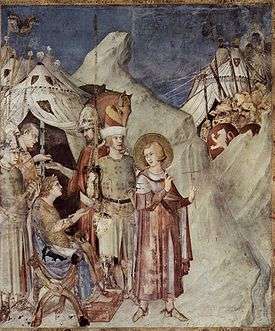
According to his biographer, Sulpicius Severus, he served in the military for only another two years, though many scholars believe that these two years, "are in fact not nearly enough to bring the account to the time when he would leave, that is, during his encounter with Caesar Julian (the one who has gone down in history as Julian the Apostate) Martin would have been 45 years old when Julian acceded to the throne, and at the usual end of a military contract. Jacques Fontaine thinks that the biographer was somewhat embarrassed about referring to [Martin's] long stint in the army, [because of the perennially tenuous relation between the Christian conscience and war]."[4] Such scholars hold that Martin would have remained in the army for the entirety of his prescribed twenty-five year term, and that, in their opinion, such service need not have obliged him to violate his Christian conscience by shedding blood on the battlefield. Regardless of whether or not he remained in the army, Sulpicius Severus reports that just before a battle in the Gallic provinces at Borbetomagus (now Worms, Germany), Martin determined that his faith prohibited him from fighting, saying, "I am a soldier of Christ. I cannot fight."[5] He was charged with cowardice and jailed, but in response to the charge, he volunteered to go unarmed to the front of the troops. His superiors planned to take him up on the offer, but before they could, the invaders sued for peace, the battle never occurred, and Martin was released from military service.[6]
Monk and hermit
Martin declared his vocation, and made his way to the city of Caesarodunum (now Tours), where he became a disciple of Hilary of Poitiers, a chief proponent of Trinitarian Christianity.[7] He opposed the Arianism of the Imperial Court. When Hilary was forced into exile from Pictavium (now Poitiers), Martin returned to Italy. According to Sulpicius Severus, he converted an Alpine brigand on the way, and confronted the Devil himself. Having heard in a dream a summons to revisit his home, Martin crossed the Alps, and from Milan went over to Pannonia. There he converted his mother and some other persons; his father he could not win. While in Illyricum he took sides against the Arians with so much zeal that he was publicly scourged and forced to leave.[7] Returning from Illyria, he was confronted by the Arian archbishop of Milan Auxentius, who expelled him from the city. According to the early sources, Martin decided to seek shelter on the island then called Gallinaria, now Isola d'Albenga, in the Ligurian Sea, where he lived the solitary life of a hermit.
With the return of Hilary to his see in 361, Martin joined him and established a hermitage nearby, which soon attracted converts and followers. The crypt under the parish church (not the current Abbey Chapel) reveals traces of a Roman villa, probably part of the bath complex, which had been abandoned before Martin established himself there. This site was developed into the Benedictine Ligugé Abbey, the oldest monastery known in Europe.[8] It became a centre for the evangelisation of the country districts. He travelled and preached through western Gaul: "The memory of these apostolic journeyings survives to our day in the numerous local legends of which Martin is the hero and which indicate roughly the routes that he followed."[2]
Bishop
In 371 Martin was acclaimed bishop of Tours, where he impressed the city with his demeanour. He had been drawn to Tours by a ruse — he was urged to come to minister to someone sick — and was brought to the church, where he reluctantly allowed himself to be consecrated bishop.[9] According to one version, he was so unwilling to be made bishop that he hid in a barn full of geese, but their cackling at his intrusion gave him away to the crowd; that may account for complaints by a few that his appearance was too disheveled to be commensurate with a bishopric, but the critics were hugely outnumbered.
As bishop, Martin set to enthusiastically ordering the destruction of pagan temples, altars and sculptures. Scholars suggest the following account may indicate the depth of the Druidic folk religion in relation to the veneer of Roman classical culture in the area:
"[W]hen in a certain village he had demolished a very ancient temple, and had set about cutting down a pine-tree, which stood close to the temple, the chief priest of that place, and a crowd of other heathens began to oppose him; and these people, though, under the influence of the Lord, they had been quiet while the temple was being overthrown, could not patiently allow the tree to be cut down".[10]
Sulpicius affirms that Martin withdrew from the city to live in Marmoutier (Majus Monasterium), the monastery he founded, which faces Tours from the opposite shore of the Loire. Recent excavations under the abbey church have revealed the traces of a Roman posting station, beside the main Roman road along the north bank of the Loire, which seems to have been the original dwelling for the community; the 'caves' on the site are post-Roman and are probably the result of quarrying the coteau for the Romanesque abbey buildings.
"Here Martin and some of the monks who followed him built cells of wood; others lived in caves dug out of the rock" (Sulpicius Severus). Martin introduced a rudimentary parish system. Once a year the bishop visited each of his parishes, traveling on foot, or by donkey or boat. He continued to set up monastic communities, and extended the bounds of his episcopate from Touraine to such distant points as Chartres, Paris, Autun, and Vienne.
In one instance, the pagans agreed to fell their sacred fir tree, if Martin would stand directly in its path. He did so, and it miraculously missed him. Sulpicius, a classically educated aristocrat, related this anecdote with dramatic details, as a set piece. Sulpicius could not have failed to know the incident the Roman poet Horace recalls in several Odes, of his narrow escape from a falling tree.[11]
Martin was so dedicated to the freeing of prisoners that when authorities, even emperors, heard he was coming, they refused to see him because they knew he would request mercy for someone and they would be unable to refuse.
On behalf of the Priscillianists
The churches of other parts of Gaul and in Spain were being disturbed by the Priscillianists, an ascetic sect, named after its leader, Priscillian. The First Council of Saragossa had forbidden several of Priscillian's practices (albeit without mentioning Priscillian by name), but Priscillian was elected bishop of Avila shortly thereafter. Ithacius of Ossonoba appealed to the emperor Gratian, who issued a rescript against Priscillian and his followers. After failing to obtain the support of Ambrose of Milan and Pope Damasus I, Priscillian appealed to Magnus Maximus, who had usurped the throne from Gratian.[12]
Although greatly opposed to the Priscillianists, Martin traveled to the Imperial court of Trier to remove them from the secular jurisdiction of the emperor. With Ambrose, Martin rejected Bishop Ithacius’s principle of putting heretics to death—as well as the intrusion of the emperor into such matters. He prevailed upon the emperor to spare the life of the heretic Priscillian. At first, Maximus acceded to his entreaty, but, when Martin had departed, yielded to Ithacius and ordered Priscillian and his followers to be beheaded (385). Martin then pleaded for a cessation of the persecution of Priscillian’s followers in Spain.[9] Deeply grieved, Martin refused to communicate with Ithacius, until pressured by the Emperor.
Martin died in Candes-Saint-Martin, Gaul (central France) in 397.
The Abbey of Marmoutier
The Abbey of Marmoutier was a monastery just outside today's city of Tours in Indre-et-Loire, France established by Martin around 372. The saint founded the monastery to escape attention and live life as a monastic. The Abbey at Tours was one of the most prominent and influential establishments in medieval France. Charlemagne awarded the position of Abbot to his friend and adviser Alcuin, the great English scholar and educator. At this time the Abbot could travel between Tours and the court at Trier in Germany and always stay overnight at one of his own properties. It was at Tours that Alcuin's scriptorium (a room in monasteries devoted to the copying of manuscripts by monastic scribes) developed Caroline minuscule, the clear round hand which made manuscripts far more legible.
In later times the abbey was destroyed by fire on several occasions and ransacked by Norman Vikings in 853 and in 996. Rebuilt beginning in 1014, by Hervé de Buzançais, treasurer of Saint Martin, to accommodate the crowds of pilgrims and to attract them, the shrine of St. Martin of Tours became a major stopping-point on pilgrimages. In 1453 the remains of Saint Martin were transferred to a magnificent new reliquary donated by Charles VII of France and Agnes Sorel.
During the French Wars of Religion, the basilica was sacked by the Protestant Huguenots in 1562. It was disestablished during the French Revolution.[13] It was deconsecrated, used as a stable, then utterly demolished. Its dressed stones were sold in 1802 after two streets were built across the site, to ensure the abbey would not be reconstructed.
Legend of Martin's cloak

While Martin was a soldier in the Roman army and stationed in Gaul (modern-day France), he experienced a vision, which became the most-repeated story about his life. One day as he was approaching the gates of the city of Amiens, he met a scantily clad beggar. He impulsively cut his military cloak in half to share with the man. That night, Martin dreamed of Jesus wearing the half-cloak he had given away. He heard Jesus say to the angels: "Martin, who is still but a catechumen, clothed me with this robe." (Sulpicius, ch 2). In another version, when Martin woke, he found his cloak restored to wholeness. The dream confirmed Martin in his piety, and he was baptised at the age of 18.[9]
The part kept by himself became the famous relic preserved in the oratory of the Merovingian kings of the Franks at the Marmoutier Abbey near Tours.[2] During the Middle Ages, the supposed relic of St. Martin’s miraculous cloak, (cappa Sancti Martini) was carried by the king even into battle, and used as a holy relic upon which oaths were sworn. The cloak is first attested in the royal treasury in 679, when it was conserved at the palatium of Luzarches, a royal villa that was later ceded to the monks of Saint-Denis by Charlemagne, in 798/99.[14]
The priest who cared for the cloak in its reliquary was called a cappellanu, and ultimately all priests who served the military were called cappellani. The French translation is chapelains, from which the English word chaplain is derived.[15]
A similar linguistic development took place for the term referring to the small temporary churches built for the relic. People called them a "capella", the word for a little cloak. Eventually, such small churches lost their association with the cloak, and all small churches began to be referred to as "chapels".[16]
Hagiography
The early life of Saint Martin was written by Sulpicius Severus, who knew him personally.[17] It expresses the intimate closeness the 4th-century Christian felt with the Devil in all his disguises, and has many accounts of miracles. Some follow familiar conventions— casting out devils, raising the paralytic and the dead. Others are more unusual: turning back the flames from a house while Martin was burning down the Roman temple it adjoined; deflecting the path of a felled sacred pine; the healing power of a letter written from Martin.
Veneration

The veneration of Martin was widely popular in the Middle Ages, above all in the region between the Loire and the Marne, where Le Roy Ladurie and Zysberg noted the densest accretion of hagiotoponyms[18] commemorating Martin.[19] Venantius Fortunatus had earlier declared, "Wherever Christ is known, Martin is honored."[20]
When Bishop Perpetuus took office at Tours in 461, the little chapel over Martin's grave, built in the previous century by Martin's immediate successor, Bricius,[21] was no longer sufficient for the crowd of pilgrims it was already drawing. Perpetuus built a larger basilica, 38 m long and 18 m wide, with 120 columns.[22] Martin's body was taken from the simple chapel at his hermitage at Candes-St-Martin to Tours and his sarcophagus was reburied behind the high altar of the new basilica.[23] A large block of marble above the tomb, the gift of bishop Euphronius of Autun (472-475), rendered it visible to the faithful gathered behind the high altar. Werner Jacobsen suggests it may also have been visible to pilgrims encamped in the atrium of the basilica.[24] Contrary to the usual arrangement, the atrium was situated behind' the church, close to the tomb in the apse, which may have been visible through a fenestrella in the apse wall.
St. Martin's popularity can be partially attributed to his adoption by successive royal houses of France. Clovis, King of the Salian Franks, one of many warring tribes in sixth-century France, promised his Christian wife Clotilda that he would be baptised if he was victorious over the Alemanni. He credited the intervention of St Martin with his success, and with several following triumphs, including the defeat of Alaric II. The popular devotion to St Martin continued to be closely identified with the Merovingian monarchy: in the early seventh century Dagobert I commissioned the goldsmith Saint Eligius to make a work in gold and gems for the tomb-shrine.[25] The bishop Gregory of Tours wrote and distributed an influential Life filled with miraculous events of St. Martin's career. Martin's cultus survived the passage of power to their successors, the Carolingian dynasty.
Revival of the popular devotion to St. Martin in the Third Republic
Excavations and rediscovery of the tomb
In 1860 excavations by Leo Dupont (1797–1876) established the dimensions of the former abbey and recovered some fragments of architecture. The tomb of St. Martin was rediscovered on December 14, 1860, which aided in the nineteenth-century revival of the popular devotion to St. Martin.
After the radical Paris Commune of 1871, there was a resurgence of conservative Catholic piety, and the church decided to build a basilica to St. Martin. They selected Victor Laloux as architect. He eschewed Gothic for a mix of Romanesque and Byzantine, sometimes defined as neo-Byzantine.[26] The new Basilique Saint-Martin was erected on a portion of its former site, which was purchased from the owners. Started in 1886, the church was consecrated 4 July 1925.[27]
Franco-Prussian War
Scholars believe that Martin’s renewed popularity was related to his association as a military saint during the Franco-Prussian War of 1870-1871. During the military and political crisis of the Franco-Prussian war, Napoleon III's Second Empire collapsed. After the surrender of Napoleon to the Prussians after the Battle of Sedan in September 1870, a provisional government of national defense was established, and France's Third Republic was proclaimed. Paris was evacuated due to the advancing enemy and for a brief time, Tours (September–December 1870) became the effective capital of France.
St Martin was promoted by the clerical right as the protector of the nation against the German threat. Conservatives associated the dramatic collapse of Napoleon III’s regime as a sign of divine retribution on the irreligious emperor. Priests interpreted it as punishment for a nation led astray due to years of anti-clericalism. They preached repentance and a return to religion for political stability. The ruined towers of the old royal basilica of St. Martin at Tours came to symbolize the decline of traditional Catholic France.[28]
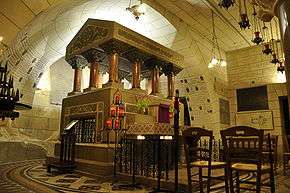
With the government's relocation to Tours during the Franco-Prussian War, 1870, numerous pilgrims were attracted to St. Martin’s tomb. It was covered by a temporary chapel built by Monsignor Guibert (archbishop of Tours, 1857-1871). The popular devotion to St. Martin was also associated with the nationalistic devotion to the Sacred Heart. The flag of Sacre-Coeur, borne by Ultramontane Catholic Pontifical Zouaves who fought at Patay, had been placed overnight in St. Martin’s tomb before being taken into battle on October 9, 1870. The banner read "Heart of Jesus Save France" and on the reverse side Carmelite nuns of Tours embroidered "Saint Martin Protect France".[29]As the French army was victorious in Patay, many among the faithful took the victory to be the result of divine favor. Popular hymns of the 1870s developed the theme of national protection under the cover of Martin's cloak, the "first flag of France".[28]
During the nineteenth-century Frenchmen, influenced by secularism, agnosticism, and anti-clericalism, deserted the church in great numbers. As Martin was a man's saint, the devotion to him was an exception to this trend. For men serving in the military, Martin of Tours was presented by the Catholic Right as the masculine model of principled behavior. He was a brave fighter, knew his obligation to the poor, shared his goods, performed his required military service, followed legitimate orders, and respected secular authority.[30] The story of his refusing to bear arms was conveniently forgotten.
Opposition from Anticlericals
During the 1870s, the procession to St. Martin's tomb at Tours became a display of ecclesiastical and military cooperation. Army officers in full uniform acted as military escorts, symbolically protecting the clergy and clearing the path for them. Anti-clerics viewed the staging of public religious processions as a violation of civic space. In 1878, M. Rivière, the provisional mayor of Tours, with anticlerical support banned the November procession in honor of St. Martin. President Patrice de Mac-Mahon, was succeeded by the Republican Jules Grévy, who created a new national anticlerical offensive. Bishop Louis-Édouard-François-Desiré Pie of Poitiers united conservatives and devised a massive demonstration for the November 1879 procession. Pie's ultimate hope was that St Martin would stop the “chariot” of modern society, and lead to the creation of a France where the religious and secular sectors merged.
The struggle between the two men was reflective of that between conservatives and anti-clerics over the church’s power in the army. From 1874, military chaplains were allowed in the army in times of peace, but anti-clerics viewed the chaplains as sinister monarchists and counter-revolutionaries. Conservatives responded by creating the short-lived Legion de Saint Maurice in 1878 and the society, Notre Dame de Soldats, to provide unpaid voluntary chaplains with financial support. The legislature passed the anticlerical Duvaux Bill of 1880, which reduced the number of chaplains in the French army. Anticlerical legislators wanted commanders, not chaplains, to provide troops with moral support and to supervise their formation in the established faith of "patriotic Republicanism."[31]
St. Martin as a French Republican patron
St. Martin has long been associated with France’s royal heritage. Monsignor René François Renou (Archbishop of Tours, 1896–1913) worked to associate St. Martin as a specifically "republican" patron. Renou had served as a chaplain to the 88e Régiment des mobils d'Indre-et-Loire during the Franco-Prussian war and was known as the "army bishop." Renou was a strong supporter of St. Martin and believed that the national destiny of France and all its victories were attributed to him. He linked the military to the cloak of St. Martin, which was the “first flag of France” to the French tricolor, “the symbol of the union of the old and new.” This flag symbolism connected the devotion to St. Martin with the Third Republic. But, the tensions of the Dreyfus Affair renewed anti-clericalism in France and drove a wedge between the Church and the Republic. By 1905, the influence of Rene Waldeck-Rousseau and Emile Combes, combined with deteriorating relations with the Vatican, led to the separation of church and state.[32]
St. Martin’s popularity was renewed during the First World War. Anticlericalism declined, and priests served in the French forces as chaplains. More than 5,000 of them died in the war. In 1916, Assumptionists organized a national pilgrimage to Tours that attracted people from all of France. The devotion to St. Martin was amplified in the dioceses of France, where special prayers were offered to the patron saint. When the armistice was signed on Saint Martin’s Day, 11 November 1918, the French people saw it was a sign of his intercession in the affairs of France.[33]
Patronage
He is the patron saint of beggars (because of his sharing his cloak), wool-weavers and tailors (also because of his cloak), soldiers (or some emphasise infantrymen), geese (some say because they gave his hiding place away when he tried to avoid being chosen as bishop, others because their migration coincides with his feast), vintners and innkeepers (because his feast falls just after the late grape harvest), and France.
Iconography
Martin is most generally portrayed on horseback dividing his cloak with the beggar. His emblem in English art is often that of a goose, whose annual migration is about late Autumn.[34]
Hammer of Martin of Tours
.tif.jpg)
The Museum Catharijneconvent in Utrecht[35] has a relic in its collection which is called "the hammer of Martin of Tours" (Latin: maleus beati Martini) It was made in the 13th or 14th century from a late Bronze Age stone axe from ca. 1,000 - 700 BCE,[35] though the dating is uncertain.[35] The grip contains a Latin text saying "Ydola vanurunt Martini cesa securi nemo deos credat qui sic fuerant ruicuri" ("the pagan statues fall down, hit by St. Martin's ax. Let nobody believe that those are gods, who so easily fall down"). Legend says that the ax belonged to St. Martin, and was used to hit the devil and to destroy the heathen temples and statues.
Influence
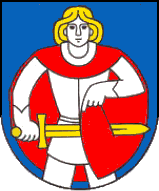
By the early 9th century, respect for Saint Martin was well-established in Ireland. His monastery at Marmoûtiers became the training ground for many Celtic missions and missionaries. Some believe that St. Patrick was his nephew and that Patrick was one of many Celtic notables who lived for a time at Marmoûtiers. St. Ninian definitely studied at Marmoûtiers and was profoundly influenced by Martin, carrying a deep love and respect for his teacher and his methods back to Scotland. Ninian was in the process of building a church when news reached him of Martin's death. Ninian dedicated that church to Martin. The Book of Armagh, contains three distinct groups of material (1) A complete text of the New Testament, (2) A dossier of materials on Saint Patrick and (3) almost the complete body of writings on Saint Martin by Sulpicius Severus.[36]
In Jonas of Bobbio's Vita Columbani, Jonas relates that the Saint Columbanus, while travelling requested to be allowed to pray at the tomb of St Martin. The Irish palimpsest sacramentary from the mid-7th century contains the text of a mass for St Martin. In the Life of Columba, Adamnan mentions in passing that St Martin was commemorated during Mass at Iona.[36]
In his Ireland and Her Neighbours in the Seventh Century,[37] Michael Richter attributes this to the mission of Palladius seen within the wider context of the mission of Germanus of Auxerre to Britain around 429. Thus, this could be the context in which the Life of St Martin was brought from Gaul to Ireland at an early date, and could explain how Columbanus was familiar with it before he ever left Ireland.[36]
Legacy
Ligugé Abbey
Founded by Martin of Tours in 360, Ligugé Abbey is one of the earliest monastic foundations in France. The reputation of the founder attracted a large number of disciples to the new monastery; the disciples initially living in locaciacum or small huts, this name later evolved to Ligugé. Its reputation was soon eclipsed by Martin's later foundation at Marmoutier. As of 2013, the Benedictine community at Ligugé numbered twenty-five.[38]
European folk traditions

From the late 4th century to the late Middle Ages, much of Western Europe, including Great Britain, engaged in a period of fasting beginning on the day after St. Martin's Day, November 11. This fast period lasted 40 days, and was, therefore, called Quadragesima Sancti Martini, which means in Latin "the forty days of St. Martin." At St. Martin's eve and on the feast day, people ate and drank very heartily for a last time before they started to fast. This fasting time was later called "Advent" by the Church and was considered a time for spiritual preparation for Christmas.
On St. Martin's Day, children in Flanders, the southern and north-western parts of the Netherlands, and the Catholic areas of Germany and Austria still participate in paper lantern processions. Often, a man dressed as St. Martin rides on a horse in front of the procession. The children sing songs about St. Martin and about their lanterns. The food traditionally eaten on the day is goose, a rich bird. According to legend, Martin was reluctant to become bishop, which is why he hid in a stable filled with geese. The noise made by the geese betrayed his location to the people who were looking for him.
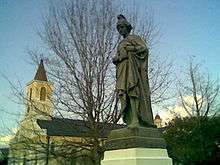
In the east part of the Belgian province of East-Flanders (Aalst) and the west part of West Flanders (Ypres), traditionally children receive presents from St. Martin on November 11, instead of from Saint Nicholas on December 6 or Santa Claus on December 25. They also have lantern processions, for which children make lanterns out of beets. In recent years, the lantern processions have become widespread as a popular ritual, even in Protestant areas of Germany and the Netherlands. Most Protestant churches no longer officially recognize Saints.
In Portugal, where the saint's day is celebrated across the country, it is common for families and friends to gather around the fire in reunions called magustos, where they typically eat roasted chestnuts and drink wine, jeropiga (drink made of grape must and firewater) and aguapé (a sort of weak and watered-down wine). According to the most widespread variation of the cloak story, Saint Martin cut off half of his cloak in order to offer it to a beggar and along the way, he gave the remaining part to a second beggar. As he faced a long ride in a freezing weather, the dark clouds cleared away and the sun shone so intensely that the frost melted away. Such weather was rare for early November, so was credited to God's intervention. The phenomenon of a sunny break to the chilly weather on Saint Martin's Day (11 November) is called Verão de São Martinho (Saint Martin's Summer, veranillo de san Martín in Spanish) in honor of the cloak legend.
Many churches are named after Saint Martin of Tours. St Martin-in-the-fields, at Trafalgar Square in the centre of London, has a history appropriately associated with Martin's renunciation of war; Dick Sheppard, founder of the Peace Pledge Union, was Vicar 1914-26, and there is a memorial chapel for him, with a plaque for Vera Brittain, also a noted Anglican pacifist; the steps of the church are often used for peace vigils. Saint Martin's Cathedral, in Ypres, Belgium, is dedicated to him. St. Martin is the patron saint of Szombathely, Hungary, with a church dedicated to him, and also the patron saint of Buenos Aires. In the Netherlands, he is the patron of the cathedral and city of Utrecht. He is the patron of the city of Groningen; its Martini tower and Martinikerk (Groningen) (Martin's Church) were named for him. He is also the patron of the church and town of Bocaue.[39]
St. Martin's Church in Kaiserslautern, Germany is a major city landmark. It is located in the heart of the city's downtown in St. Martin's Square, and is surrounded by a number of restaurants and shops. The church was originally built as a Franciscan monastery in the 14th century and has a number of unique architectural features.[40]
St. Martin is the patron saint of the Polish towns of Bydgoszcz and Opatów. His day is celebrated with a procession and festivities in the city of Poznań, where the main street (Święty Marcin) is named for him, after a 13th-century church in his honor. A special type of crescent cake (rogal świętomarciński) is baked for the occasion. As November 11 is also Polish Independence Day, it is a public holiday.
In Latin America, St. Martin has a strong popular following and is frequently referred to as San Martín Caballero, in reference to his common depiction on horseback. Mexican folklore believes him to be a particularly helpful saint toward business owners.
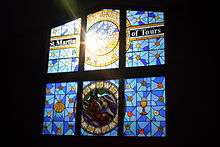
San Martín de Loba is the name of a municipality in the Bolívar Department of Colombia. Saint Martin, as San Martín de Loba, is the patron saint of Vasquez, a small village in Colombia.
Though no mention of St. Martin's connection with viticulture is made by Gregory of Tours or other early hagiographers, he is now credited with a prominent role in spreading wine-making throughout the Touraine region and the planting of many vines. The Greek myth that Aristaeus first discovered the concept of pruning the vines, after watching a goat eat some of the foliage, has been adopted for Martin.[41] He is also credited with introducing the Chenin blanc grape varietal, from which most of the white wine of western Touraine and Anjou is made.
Martin Luther was named after St. Martin, as he was baptised on November 11 (St. Martin's Day), 1483. Many older Lutheran congregations are named after St. Martin, which is unusual (for Lutherans) because he is a saint who does not appear in the Bible. (Lutherans regularly name congregations after the evangelists and other saints who appear in the Bible but are hesitant to name congregations after post-Biblical saints.)
Martin of Tours is the patron saint of the U.S. Army Quartermaster Corps, which has a medal in his name.[42] The Church Lads' and Church Girls' Brigade, a 5-7 age group, was renamed 'Martins' in his honour in 1998.
In modern film
The Dutch film Flesh and Blood (1985) prominently features a statue of Saint Martin. A mercenary in Renaissance Italy, named Martin, finds a statue of Saint Martin cutting his cloak and takes it as a sign to desert and rogue around under the saint's protection.
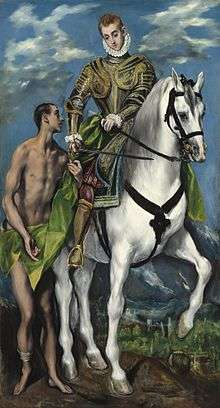 St Martin and the Beggar, by El Greco, ca. 1597-99 (National Gallery of Art, Washington)
St Martin and the Beggar, by El Greco, ca. 1597-99 (National Gallery of Art, Washington)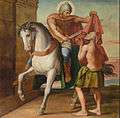 Louis-Anselme Longa, La charité de saint Martin
Louis-Anselme Longa, La charité de saint Martin Saint Martin and the Beggar by Anthony van Dyck
Saint Martin and the Beggar by Anthony van Dyck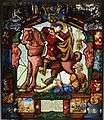 Kloster Wettingen Ost
Kloster Wettingen Ost
See also
- St. Martin's Day
- The Community of Saint Martin, an association of Roman Catholic priests.
- Martin (name)
Notes
- ↑ Lanzi, Fernando (2004). Saints and Their Symbols: Recognizing Saints in Art and in Popular Images. Liturgical Press. p. 104. ISBN 0-8146-2970-9. Retrieved 2008-07-19.
- 1 2 3 4 "Clugnet, Léon. "St. Martin of Tours." The Catholic Encyclopedia. Vol. 9. New York: Robert Appleton Company, 1910. 4 Jun. 2013".
- ↑ Clare Stancliffe, St Martin and his hagiographer: History and miracle in Sulpicius Severus (Oxford, Clarendon Press, 1983) 119-133
- ↑ Pernoud, Regine (2006). Martin of Tours: Soldier, Bishop, Saint. p 29.
- ↑ SULPITIUS SEVERUS ON THE LIFE OF ST. MARTIN. Translation and Notes by Alexander Roberts. From: A Select Library of Nicene and Post-Nicene Fathers of the Christian Church, Second Series, Volume 11. New York, 1894. accessed 15th January 2015.
- ↑ Kurlansky, Mark (2006). Nonviolence: Twenty-five Lessons from the History of a Dangerous Idea. pp 26-27.
- 1 2 "Crawley, John J. Lives of the Saints, John J. Crawley & Co. Inc.". St. Martin of Tours Catholic Church.
- ↑ "Benedict XVI. ""Generous Witness of the Gospel of Charity", 11 November 2007". ZENIT — The World Seen From Rome.
- 1 2 3 "Foley O.F.M., Leonard. Saint of the Day, Lives, Lessons, and Feast, (revised by Pat McCloskey O.F.M.), Franciscan Media, ISBN 978-0-86716-887-7".
- ↑ Sulpicius, Vita ch. xiii
- ↑ Odes ii.13 and .17 and iii.4 (me truncus elapsus cerebro sustulerat nisi faunus ictum dextra levasset)
- ↑ Chadwick, Henry. Priscillian of Avila: The Occult and the Charismatic in the Early Church (Oxford: Clarendon Press, 1976), pp. 42-44.
- ↑ Farmer, Sharon (1991). Communities of St. Martin: Legend and Ritual in Medieval Tours, Pp. 78-96.
- ↑ J.-P. Brunterch, in Un village au temps de Charlemagne, pp. 90-93, noted in François-Olivier Touati, Maladie et société au Moyen âge (Paris/Brussels, 1998) p. 216 note 100.
- ↑ Ducange, Glossarium, s.v "Capella)", noted in Encyclopaedia Britannica 1911, s.v. "Chapel".
- ↑ MacCulloch, Daimaid (2009). A History of Christianity: The First Three Thousand Years. Penguin Group. ISBN 1-101-18945-2.
- ↑ "Sulpicius Severus. Life of St. Martin, College of St. Benedict, St. John's University; St. Joseph, Minnesota".
- ↑ A hagiotoponym is a place-name that commemorates a saint.
- ↑ Emmanuel Le Roy Ladurie and A. Zysberg, "Géographie des hagiotoponymes en France", Annales E.S.C. (1983), map p. 1331.
- ↑ Quoted by Louis Réau, Iconographie de I'art chretien, p. 902.
- ↑ "Hic aedificavit basilicam parvulam super corpus beati Martini, in qua et ipse sepultus est" (Gregory, Libri historiarum 10.31, quoted in Werner Jacobsen, "Saints' Tombs in Frankish Church Architecture" Speculum 72.4 (October 1997:1107-1143) p. 1108.
- ↑ The details are in Gregory, Libri historiarum 2.14
- ↑ May Viellard-Troiëkouroff, "La basilique de Saint-Martin de Tours de Perpetuus (470) d'après les fouilles archéologiques", Actes du 22e Congrès international d'histoire d'art 1966. (Budapest 1972), vol. 2:839-46); Charles Lelong, La basilique de Saint-Martin de Tours (Chambray-lès-Tours 1986).
- ↑ Jacobsen 1997:1108f.
- ↑ Vita Eligii: "miro opificio exaure et gemmis contextuit sepulchrum:; quoted in Jacobsen 1997:1109 note 11.
- ↑ Note: Pilgrimage basilicas in comparable Romanesque-Byzantine taste being erected during the same period are the Basilique du Sacré-Cœur, Paris and in Lyon the basilica of Notre-Dame de Fourvière.
- ↑ "Historique". "Basilique Saint-Martin" (official website) (in French). Retrieved 2008-09-16.
- 1 2 Brennan, pp 489-491.
- ↑ Brennan, p 499.
- ↑ Brennan, pp 491-492.
- ↑ Brennan, pp 495-496.
- ↑ Brennan, Brian (1997). “The Revival of the Cult of Martin of Tours in the Third Republic”. Pp 497-499.
- ↑ Brennan, Brian (1997). “The Revival of the Cult of Martin of Tours in the Third Republic”. Pp 499-501.
- ↑ ""The Life of St. Martin of Tours", St. Martin's Anglican Church, Eynesford, Kent".
- 1 2 3 Catharijne Convent
- 1 2 3 Brigit. ""Irish Devotion to Saint Martin of Tours", Saint Conleth's Catholic Heritage Association".
- ↑ Richter, Michael, ''Ireland and Her Neighbours in the Seventh Century, pp. 225-230, Four Courts Press, 1999
- ↑ L'Abbaye Saint-Martin de Ligugé
- ↑ "Bulacan, Philippines: Tourism: Feast of the Holy Cross of Wawa, Bocaue, Bulacan: Photo Gallery: pagoda01.jpg".
- ↑ "Stadtverwaltung Kaiserslautern".
- ↑ For instance in Hugh Johnson, Vintage: The Story of Wine 1989, p 97.
- ↑ "Quartermaster Corps: The Order of Saint Martin".
References
- Sulpicius Severus On the Life of St. Martin. Translation and Notes by Alexander Roberts. In A Select Library of Nicene and Post-Nicene Fathers of the Christian Church, New York, 1894, available online CCEL alternative link
- Brennan, Brian (1997). "The Revival of the Cult of Martin of Tours in the Third Republic", Church History
- Clare Stancliffe, St Martin and his hagiographer: History and miracle in Sulpicius Severus (Oxford, Clarendon Press, 1983), pp. xvi+400 (Oxford Historical Monographs).
- Mark Kurlansky (2006). Nonviolence: twenty-five lessons from the history of a dangerous idea. Modern Library chronicles book, Random House, Inc., New York. ISBN 0-679-64335-4.
- Yossi Maurey (2014). Medieval Music, Legend, and the Cult of St Martin: The Local Foundations of a Universal Saint. Cambridge: Cambridge University Press, 2014.
| Wikimedia Commons has media related to Martin of Tours. |
External links
| Wikimedia Commons has media related to Martin of Tours. |
- "St. Martin, Bishop of Tours, Confessor", Butler's Lives of the Saints
- The Life and Miracles of Saint Martin of Tours, Bishop and Confessor of the Catholic Church
- The Community of St Martin
- The Life of St Martin as depicted in the stained glass of Chartres Cathedral (c.1220)
- St Martin's churches of the world
- Literature by and about Martin of Tours in the German National Library catalogue
- Joachim Schäfer: Martin of Tours in the Ecumenical Lexicon of Saints
- Erzbistum Köln: 1600 Jahre Verehrung des heiligen Martin von Tours
- Martin from a historian's viewpoint
- Saint Martin Churches around the world
- Sulpicius Severus: Martinsvita (German)
- Martin von Tours: Soldat, Eremit und Heiliger, film clips by Rüdiger Achenbach in the series Tag für Tag on Deutschlandfunk, Part 1 on 6 November 2014 and Part 2 on 7 November 2014
| Preceded by Lidorius |
Bishop of Tours 371–397 |
Succeeded by Bricius |

